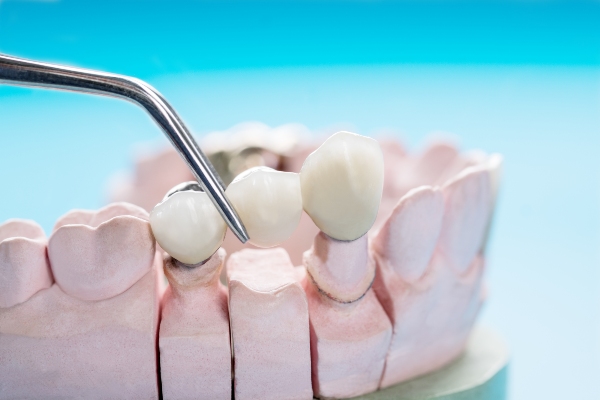 Dental bridges and dental crowns are wonderful, durable options to restore a smile. However, they are both employed for different reasons. By understanding the specifics of both, patients can learn which option is best for their needs when consulting with a dentist.
Dental bridges and dental crowns are wonderful, durable options to restore a smile. However, they are both employed for different reasons. By understanding the specifics of both, patients can learn which option is best for their needs when consulting with a dentist.
Dental bridges
Dental bridges are recommended after a tooth extraction, whether by trauma or professional intervention. When a tooth is missing, a host of issues can occur. A missing tooth or teeth can cause those in the same arch to shift. This can manifest as overcrowding in some areas and overspacing in others or cause them to jut out, creating an overbite. Missing teeth can also result in poor oral function. Poor oral function can make it difficult to form certain words when speaking, as well as make it difficult to break down food when eating.
Due to the oral appliance's design, the dentist will only recommend a dental bridge if there are one to four missing teeth in a row. The dentist will likely use a traditional bridge for the back teeth. It consists of two crowns on either side of a false tooth or pontic. The dentist then bonds the dental bridge to the two adjacent teeth on either side of the gap left by the missing tooth.
However, there are more options available. Cantilever dental bridges consist of one crown and a pontic, usually used on the front teeth since they are not as strong as traditional ones. Due to their strength, Maryland dental bridges are also an option for front missing teeth. However, they do not use crowns to support the false tooth. Instead, they have wings or flaps directly attached to the pontic. The dentist will bond these wings to the back of adjacent teeth for support.
Dental crowns
Dental crowns or caps are for those who still have their natural tooth but need to restore the tooth's look, durability, protection, and function. A dental crown treats damage caused by decay removal, root canal therapy, or a fracture. Usually, when a dentist removes the initial threat of decay or the brittle tooth layers from a fracture, the tooth is still vulnerable. The dentist must cover or engulf it with a dental crown to protect its new state.
Like a dental bridge, a crown has multiple types, meaning a number of different materials can be used to craft them. Porcelain and composite materials are the most common types the dentist will consider. Both options are strong and can closely match the patient's natural tooth color. These crowns can last upwards of 15 years with proper care.
Dental bridge and crown similarities
While they have different designs, traditional dental bridges and crowns can both be attached to dental implants. Dental implants are titanium posts that must be surgically implanted into the jawbone, acting as tooth roots for missing teeth. Both options can last for years with proper care and guidance. However, only some are candidates for these posts. A dentist can help determine a patient's candidacy.
Which is for you?
Whether you need teeth repaired or replaced, we can help. Our team can also fit you for a dental bridge or crown to complete your smile. Contact our office to schedule an appointment.
Request an appointment or call Anthony DeLucia D.D.S., P.A. at 772-492-7045 for an appointment in our Stuart office.
Related Posts
A healthy, complete smile is not only about looking good but is also important for your overall well-being. Dental bridges can help restore the appearance and function of your teeth. However, common misconceptions about these replacement options can prevent people from understanding their benefits. Let us debunk some common myths about dental bridges.While dental bridges…
Both dental bridges and implants are popular, effective tooth replacement solutions. However, there are cases in which a general dentist may recommend a dental bridge over implants. This may be due to the number of teeth missing, their location, and the strength of the underlying jawbone, among other factors. Understanding how each of these treatments…
A dental bridge is a tooth replacement option designed to fill in the gaps in your smile caused by missing teeth. Dental bridges restore the basic functions of biting and speech as well as the visual appeal of your smile. This guide explains the dental bridge procedure and how it works to replace lost teeth.Dental…
